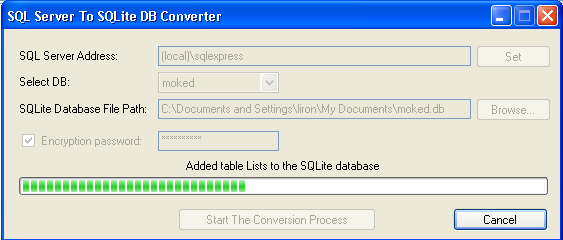While trawling the internet the other day, I came across this question, and thought it might be something that others might like to know. The question was:
What’s the best (or maybe not the best — just good) way for two processes in the same machine to communicate, using .NET?
Actually the two processes in the app I’m working on aren’t even two different programs; they’re just two instances of the same EXE. I wanted to do something like a singleton app, but have it per user (meaning a Terminal Server or Citrix or App-V server with multiple users should be able to launch their own single copy of the app). If another instance is run by the same user, it should just delegate the task to the already running instance, then exit. Only one instance per user of the program should be running. So far I’ve done (thanks to StackOverflow) the part that detects whether an instance of the app is already running, using Mutex. But I need the second app instance to be able to send data to the first app instance.
I’m leaning towards using named pipes and WCF’s NetNamedPipeBinding for this, but if you have better ideas I’ll really appreciate it. Thanks 🙂
IPC is what I’ve used in the past for this. And it is supprisingly easy. .Net remoting is a good option but unfortunately it is a restricted option becasue you can’t for example use it on the CF.
Below is a copy of the class I use to perform Inter-process Communication, you can use it in conjuction with a MutEx if you wish, but it isnt necessary. As long as the “pMappedMemoryName” and “pNamedEventName” are the same in both processes, it should work just fine. I tried to make it as event driven as possible.
The class looks a little like this:
public class IpcService {
private IServiceContext mContext;
const int maxLength = 1024;
private Thread listenerThread;
private readonly string mMappedMemoryName;
private readonly string mNamedEventName;
public event EventHandler IpcEvent;
private readonly bool mPersistantListener;
public IpcService(bool pPersistantListener)
: this(pPersistantListener, "IpcData", "IpcSystemEvent") {
;
}
public IpcService(bool pPersistantListener, string pMappedMemoryName, string pNamedEventName) {
mPersistantListener = pPersistantListener;
mMappedMemoryName = pMappedMemoryName;
mNamedEventName = pNamedEventName;
}
public void Init(IServiceContext pContext) {
mContext = pContext;
listenerThread = new Thread(new ThreadStart(listenUsingNamedEventsAndMemoryMappedFiles));
listenerThread.IsBackground = !mPersistantListener;
listenerThread.Start();
}
private void listenUsingNamedEventsAndMemoryMappedFiles() {
IntPtr hWnd = EventsManagement.CreateEvent(true, false, mNamedEventName);
while (listenerThread != null) {
if (Event.WAITOBJECT == EventsManagement.WaitForSingleObject(hWnd, 1000)) {
string data = Peek();
EventsManagement.ResetEvent(hWnd);
EventHandler handler = IpcEvent;
if (handler != null) handler(this, new TextualEventArgs(data));
}
}
EventsManagement.SetEvent(hWnd);
Thread.Sleep(500);
HandleManagement.CloseHandle(hWnd);
}
public void Poke(string format, params object[] args) {
Poke(string.Format(format, args));
}
public void Poke(string somedata) {
using (MemoryMappedFileStream fs = new MemoryMappedFileStream(mMappedMemoryName, maxLength, MemoryProtection.PageReadWrite)) {
fs.MapViewToProcessMemory(0, maxLength);
fs.Write(Encoding.ASCII.GetBytes(somedata + "\0"), 0, somedata.Length + 1);
}
IntPtr hWnd = EventsManagement.CreateEvent(true, false, mNamedEventName);
EventsManagement.SetEvent(hWnd);
Thread.Sleep(500);
HandleManagement.CloseHandle(hWnd);
}
public string Peek() {
byte[] buffer;
using (MemoryMappedFileStream fs = new MemoryMappedFileStream(mMappedMemoryName, maxLength, MemoryProtection.PageReadWrite)) {
fs.MapViewToProcessMemory(0, maxLength);
buffer = new byte[maxLength];
fs.Read(buffer, 0, buffer.Length);
}
string readdata = Encoding.ASCII.GetString(buffer, 0, buffer.Length);
return readdata.Substring(0, readdata.IndexOf('\0'));
}
private bool mDisposed = false;
public void Dispose() {
if (!mDisposed) {
mDisposed = true;
if (listenerThread != null) {
listenerThread.Abort();
listenerThread = null;
}
}
}
~IpcService() {
Dispose();
}
}
Simply use the Poke method to write data, and the Peek method to read it, although I designed it to automatically fire an event when new data is available. In this way you can simply subscribe to the IpcEvent event and not have to worry about expensive and constant polls. Enjoy.

